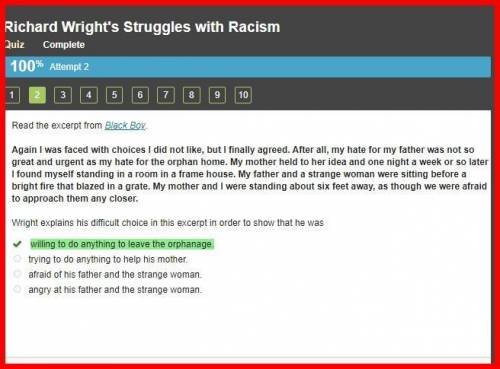
English, 05.05.2021 01:20, anahitrejo1
Again I was faced with choices I did not like, but I finally agreed. After all, my hate for my father was not so great and urgent as my hate for the orphan home. My mother held to her idea and one night a week or so later I found myself standing in a room in a frame house. My father and a strange woman were sitting before a bright fire that blazed in a grate. My mother and I were standing about six feet away, as though we were afraid to approach them any closer.
Wright explains his difficult choice in this excerpt in order to show that he was
✔willing to do anything to leave the orphanage.
trying to do anything to help his mother.
afraid of his father and the strange woman.
angry at his father and the strange woman.


Answers: 2
Other questions on the subject: English

English, 21.06.2019 13:00, shannonderemer
I’m your response, discuss how this part of the speech fits into the overall structure of the text and analyze how well it’s supports the authors overall purpose.
Answers: 2


English, 22.06.2019 03:50, tfyvcu5344
Which statement most strongly develops a positive tone? a. i was happy when i received my first paycheck for my hand work. b. winter break is approaching quickly, and i cannot wait to go shopping for gifts. c. going to the beach is one of my favorite activities; i love surfing and paddle boarding. d. a sense of accomplishment overwhelmed me as i stepped into into the stage that sunny, glorious day of graduation.
Answers: 2

English, 22.06.2019 04:50, ilawil6545
Read the passage, then answer the question that follows. no one could have seen it at the time, but the invention of beet sugar was not just a challenge to cane. it was a hint—just a glimpse, like a twist that comes about two thirds of the way through a movie—that the end of the age of sugar was in sight. for beet sugar showed that in order to create that perfect sweetness you did not need slaves, you did not need plantations, in fact you did not even need cane. beet sugar was a foreshadowing of what we have today: the age of science, in which sweetness is a product of chemistry, not whips. in 1854 only 11 percent of world sugar production came from beets. by 1899 the percentage had risen to about 65 percent. and beet sugar was just the first challenge to cane. by 1879 chemists discovered saccharine—a laboratory-created substance that is several hundred times sweeter than natural sugar. today the sweeteners used in the foods you eat may come from corn (high-fructose corn syrup), from fruit (fructose), or directly from the lab (for example, aspartame, invented in 1965, or sucralose—splenda—created in 1976). brazil is the land that imported more africans than any other to work on sugar plantations, and in brazil the soil is still perfect for sugar. cane grows in brazil today, but not always for sugar. instead, cane is often used to create ethanol, much as corn farmers in america now convert their harvest into fuel. –sugar changed the world, marc aronson and marina budhos how does this passage support the claim that sugar was tied to the struggle for freedom? it shows that the invention of beet sugar created competition for cane sugar. it shows that technology had a role in changing how we sweeten our foods. it shows that the beet sugar trade provided jobs for formerly enslaved workers. it shows that sweeteners did not need to be the product of sugar plantations and slavery.
Answers: 1
Do you know the correct answer?
Again I was faced with choices I did not like, but I finally agreed. After all, my hate for my fathe...
Questions in other subjects:


Mathematics, 01.04.2021 17:50




Mathematics, 01.04.2021 17:50

Mathematics, 01.04.2021 17:50

Business, 01.04.2021 17:50







